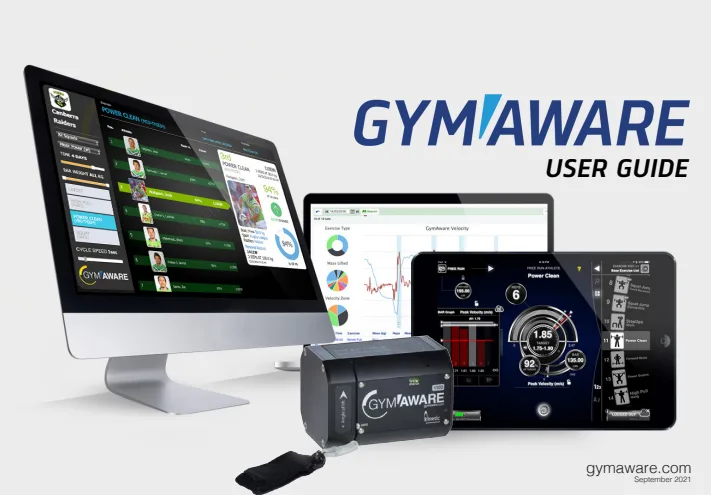GymAware™ Tests & Measurements
Consolidated from GymAware User Guide and Measurements list; duplicates removed.
Core Metrics We Measure
- Mean & Peak Velocity (concentric and eccentric); movement speed during lifting and lowering phases.
- Mean & Peak Power (concentric and eccentric); explosive output and control on the way down.
- Mean & Peak Force; total force produced (N); useful for max‑strength profiling.
- Time to Peak (velocity / power / force); rate of force development indicators.
- Rep Height / Dip / Distance / Duration & Bar Path; range and quality of motion; jump height and trajectory.
- Rate of Force Development (RFD); how quickly force is produced.
- Reactive Strength Index (RSI); flight time ÷ contact time in plyometric actions.
- Range of Motion (ROM); displacement per rep for consistency checks.
Functional Protocols & Applications
- Velocity Zones; map strength qualities (speed‑strength ↔ absolute strength) and set targets by exercise.
- Autoregulation / Daily Readiness; adjust load using today’s velocities vs baseline.
- Velocity Drop‑Off / Fatigue Thresholds; terminate a set at a preset % loss to manage fatigue.
- Force‑Velocity / Load‑Velocity Profiling; determine individual profile and training emphasis.
- 1RM Estimation via Velocity; estimate max strength safely with submaximal loads.
- Progress Tracking; monitor changes in velocity, power, force across sessions/blocks.
Prescribed Tests
1) Barbell Velocity Test (Squat / Bench / Deadlift & variants)
What it measures:
- Mean/peak concentric velocity per rep; optional eccentric velocity.
- Bar displacement and path; rep duration.
How we run it:
- Device positioned vertically under bar path; tether aligned to bar.
- Auto‑Record enabled; lift with maximal concentric intent within technical limits.
- Set exercise‑specific velocity zones (Targets).
Coaching use:
- Prescribe by velocity not just %1RM; adjust load on the day.
- Readiness and fatigue via velocity changes and drop‑off.
2) Peak Power Assessment (Dynamic Effort)
What it measures:
- Peak/mean power across multiple submaximal loads.
- Load that maximizes power for the athlete.
How we run it:
- 3–5 loads, 2–4 reps each, maximal intent; select best rep.
- Review power per rep in app/Cloud.
Coaching use:
- Identify optimal loading for power development.
- Track explosive strength changes over time.
3) Predictive 1RM (Load–Velocity Profiling)
What it measures:
- Slope and intercept of the load–velocity relationship.
- Estimated 1RM without maximal attempts.
How we run it:
- Collect 3–6 data points with consistent technique and intent.
- Use GymAware Cloud Pro predictive 1RM report.
Coaching use:
- Safer in‑season monitoring; update training zones to the current state.
4) Velocity Loss / Fatigue Monitoring
What it measures:
- Within‑set velocity drop (%) as fatigue proxy.
- Rep‑to‑rep quality under fixed load.
How we run it:
- Preset loss threshold (e.g., 15–25%); stop the set when reached.
Coaching use:
- Control fatigue, standardize effort, protect performance in‑season.
5) ROM & Bar Path Consistency Check
What it measures:
- Displacement, path overlays, rep duration/tempo.
How we run it:
- Technical loads; compare path overlays on REVIEW screen.
Coaching use:
- Technique diagnostics and asymmetry detection.
6) Machine‑Based Strength Sets (Selectorized)
What it measures:
- Velocity and power on pin‑loaded machines.
How we run it:
- Anchor near weight stack; thread strap through pin per guide.
Coaching use:
- Extend VBT beyond barbell lifts; safer accessory tracking.
7) Plyometric RSI
What it measures:
- Reactive Strength Index (flight time ÷ contact time).
How we run it:
- Use jump protocols (e.g., repeated CMJs or drop jumps) capturing flight/contact timing.
Coaching use:
- Assess stretch‑shortening cycle efficiency and reactive strength.
Notes
- Advanced analytics (predictive 1RM, longitudinal dashboards) require GymAware Cloud Pro.
- Use consistent warm‑up, depth/range standards, and cueing across sessions for valid comparisons.
- Safety first: maintain tether and device, control bar return, and follow facility procedures.
